| |
|
Company
G
and
the
Breakthrough
Story
Written by Rick Archer with help from Stan Karas
June 6, 2012
Company G of the First Infantry
was the
unit commanded by Captain Joseph Dawson on D-Day at Omaha
Beach. As you will read, Company G created the
Breakthrough that completely turned the battle around.
Company G was part of a legendary
fighting force during World War II known as the "Big Red
One" and the "Fighting First".
The picture
below is titled Into the Jaws of Death. This is one
of the most famous pictures taken at D-Day. It shows E
Company of the First Infantry headed to shore at Omaha
Beach. The 2nd Battalion of E Company was the unit that shared the credit
with G Company for helping to create the big Breakthrough during the attack at Omaha Beach.
Led by John Spalding and Philip Streczyk, E Company
would exploit the Breakthrough to become the first unit to
take out one of the deadly German resistance nests that were
killing Americans.
|
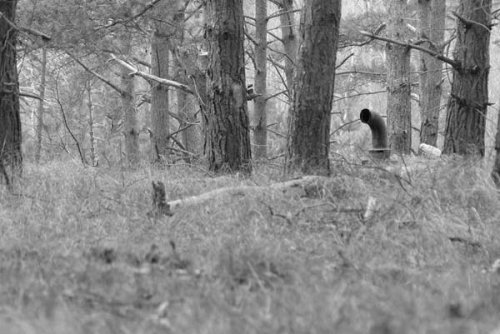 |
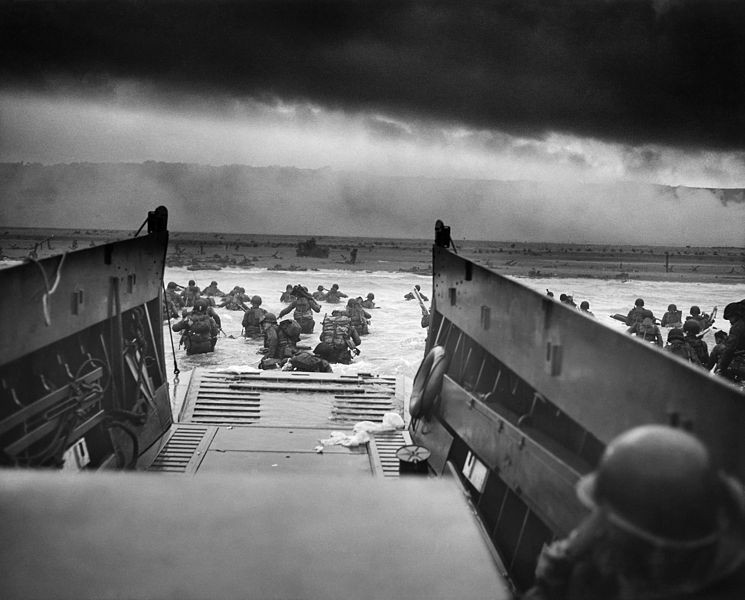 |
The 1st Infantry Division of the
United States Army is the oldest division in the Army. The First Infantry
played a key role in many major WW II battles. Using Wikipedia as
our
reference, here is a brief look at the resume of the
Fighting First during World War II.
Shortly after
the beginning of World War II in Europe, the 1st Division
was moved to Fort Benning, Georgia, in November 1939
where it supported the Infantry School as part of American
mobilization preparations. It then moved to the Sabine
Parish, Louisiana, in May 1940 to participate in the
Louisiana Maneuvers.
The division
next relocated to Fort Hamilton in June 1940, where it
spent over six months before moving to Fort Devens,
Massachusetts, in February 1941. As part of its training
that year, the division participated in the October and
November Carolina Maneuvers before returning to Ft Devens on 6 December 1941.
One day later, on December 7, 1941, the Japanese attacked
Pearl Harbor and then the United States declared war. The
division was ordered to Camp Blanding, Florida, as quickly
as trains could be gathered and winter weather permitted,
and arrived on 21 February 1942.
|
The division was
reorganized and refurbished with new equipment, being
re-designated as the 1st Infantry Division on 15 May 1942.
Within a week, the division was returned to its former post
at Fort Benning, from where it was expedited on 21 Jun 1942
to Indiantown Gap Military Reservation for wartime overseas
deployment final preparation. The division departed New York
Port of Embarkation on 1 August 1942, arrived in Beaminster
in south-west England about a week later, and departed 22
October 1942 for the combat amphibious assault of North
Africa.
As part of II Corps, the division landed in Oran, Algeria on
8 November 1942 as part of Operation Torch, the Allied
invasion of French North-Africa.[13] The 1st Division
commander was Major General Terry de la Mesa Allen and
Brigadier General Theodore Roosevelt, Jr. as deputy division
commander. Elements then took part in combat at Maktar,
Tebourba, Medjez el Bab, the Battle of the Kasserine Pass
(where American forces were pushed back), and Gafsa. It then
led the allied assault in brutal fighting at El Guettar,
Béja, and Mateur. The 1st Infantry Division was in combat in
the North African Campaign from 21 January 1943 – 9 May
1943, helping secure Tunisia.
In July 1943, the division took part in Operation Husky
invading Sicily still under the command of Major General
Allen. Lieutenant General George S. Patton, Jr. specifically
requested the Big Red One as part of his forces for the
invasion of Sicily. It was assigned to the II Corps. It was
in Sicily that the 1st saw heavy action when making
amphibious landings opposed by Italian and German tanks at
the Amphibious Battle of Gela. The 1st then moved up through
the center of Sicily, slogging it out through the mountains
along with the 45th Infantry Division. In these mountains,
the division saw some of the heaviest fighting in the entire
Sicilian campaign at the Battle of Troina; some units losing
more than half their strength in assaulting the mountain
town. On 7 August 1943, command was assumed by Major General
Clarence R. Huebner.
When that campaign was over, the division returned to
England 5 November 1943 to prepare for the eventual Normandy
invasion. The First Infantry Division and one Regimental
Combat Team from the 29th Infantry Division comprised the
first wave of troops that assaulted German Army defenses on
Omaha Beach on D-Day. Some of the division's units
suffered 30 percent casualties in the first hour of the
assault. They secured Formigny and Caumont in the
beachhead by the end of the day.
The division
followed up the Saint-Lô break-through with an attack on
Marigny, 27 July 1944, and then drove across France in a
continuous offensive, reaching the German border at Aachen
in September. The division laid siege to Aachen, taking the
city after a a direct assault on 21 October 1944.
The First then
attacked east of Aachen through the Hurtgen Forest, driving
to the Ruhr, and was moved to a rear area 7 December 1944
for refitting and rest following 6 months of combat. When
the German Wacht Am Rhein offensive (commonly called the
Battle of the Bulge) was launched on 16 December 1944,
the division was quickly moved to the Ardennes front.
Fighting continuously from 17 December 1944 to 28 January
1945, the division helped to blunt and reverse the German
offensive.
Thereupon the
division attacked and again breached the Siegfried Line,
fought across the Ruhr, 23 February 1945, and drove on to
the Rhine, crossing at the Remagen bridgehead, 15–16 March.
The division broke out of the bridgehead, took part in the
encirclement of the Ruhr Pocket, captured Paderborn, pushed
through the Harz Mountains. The First was in
Czechoslovakia, fighting at Kinsperk, Sangerberg, and
Mnichov when the war in Europe ended.
Sixteen
members of the division were awarded the Medal of Honor.
|
| |
|
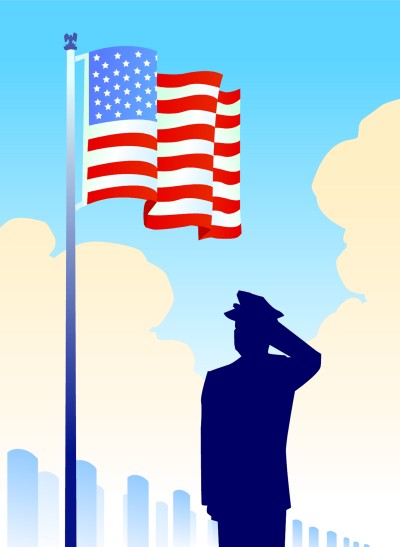 |
Stanley Karas, War Hero
Rick Archer's Note
June 6, 2012
It has now been one
year since I wrote my article on D-Day. In the past
year, I have received several kind words about the story.
Although I enjoy
receiving a compliment as much as the next guy, in this
situation I wish only to help preserve the memories of the
men who risked their lives on D-Day. Let us never
forget the sacrifice. That is the main purpose of
my articles.
Among the
letters I received, I was most touched by a letter sent by
Stan Karas of Neptune, New Jersey.
As we exchanged
correspondence, one day I suddenly realized I was writing to a man
whose father was a war hero.
Here is what
I wrote:
"Stan, I've
been thinking about your letter. I just realized that "G
Company" was Joe Dawson's command.
Your father must have fought right alongside Joe Dawson,
yes?
If so, was your father one of the men wounded by the
stupid Naval bombing of Colleville in the afternoon?"
|
Response from Stan Karas Jr
My father
was with Dawson every step of the way. He was Dawson's
2nd in command. That's why your story has me so excited.
I have a "G" Company Officer Roster for 6 Jun 44 that puts my
Dad in Dawson's landing craft. Dawson's book
From Omaha Beach to Dawson's Ridge tells how
the two of them had an emotional return to Easy Red
beach a few weeks later when things were secure and my
father had rejoined the Company after his wounds at
Colleville.
No, my Dad was
not hit by the Naval bombing, but a lot of his friends
were hit.
The Germans
got Dad. A machine pistol bullet shattered my
dad's helmet visor. He was knocked out with a
concussion. A fragment took out a small chuck of
the white of his eye at Colleville.
He was
blinded for a while, but his vision came back
100%. My father and a small group of five officers went
AWOL from an English hospital and "hitchhiked" back to
France because they were afraid they would get
reassigned out of the 1st Division if they were on leave
too long. They could not bear the thought of being
separated from their buddies.
Stan Karas Jr
offered to send me some newspaper articles written about his
father.
As I researched
the World War II exploits of Lt Colonel Stanley Karas, my
jaw dropped. This man participated in eight different
campaigns. Karas was wounded on four separate
occasions, but he refused to let that stop him. Every
time he came back to fight again.
Let me share
some of the war accomplishments of Stanley A Karas.
Stan
Karas was a highly decorated soldier during WW II.
Born in Newark, New Jersey, Karas joined the army in
1932. The war started for him in 1942. He
was assigned to the First Division in Africa.
During the African campaign, Karas was promoted from
Staff Sergeant to Second Lieutenant by Major General
Terry Allen.
In Sicily,
Karas received the DSC (Distinguished Service Cross) on
11 July 1943 for taking on five German tanks. His
citation read:
|
"Lt. Karas'
platoon was attacked on its left flank by five enemy
tanks. Karas held his ground steadfastly until overrun
by the tanks. Then under extremely heavy artillery and
machine gun fire from the attacking tanks, Karas moved
his platoon into position with the remainder of the
company. After reorganizing his men and encouraging them
to fight on, Karas rounded up a gun crew and manned an
abandoned anti-tank gun.
When he
had exhausted his ammunition, Karas fearlessly dashed to
an earlier gun position to secure more ammunition.
Returning under intense fire to his anti-tank gun, he
resumed firing.
Karas'
outstanding bravery and magnificent devotion to duty
were of inestimable value in bolstering the spirit of
the men fighting beside him. His brilliant organization
and leadership ability were instrumental in the
successful conclusion of this vital engagement with the
enemy."
|
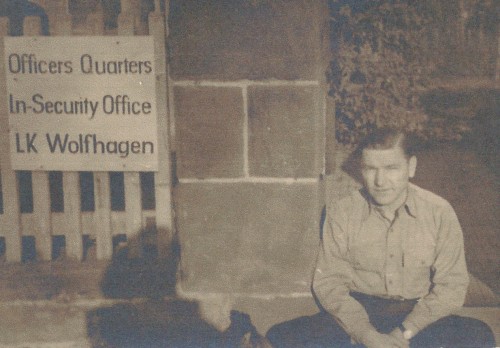 |
Stan Karas would go on to serve his country with great
bravery throughout the war. Karas suffered his first
wound in Africa. He suffered his second wound in
Sicily.
Karas suffered his third wound during the
D-Day invasion. He
was badly hurt during an afternoon skirmish at Colleville
on D-Day.
A German pistol bullet fragmented on his helmet visor and
a shard hit him in the eye.
He was blind. Fortunately it was only temporary.
Karas
was out for only a month.
By coincidence, Joe
Dawson, Karas' commanding officer, had also just returned to action.
Like Karas, Dawson was wounded at Colleville when he took a bullet
fragment in his knee.
The two men were excited
to be re-united. One morning in early July 1944 they decided to take
an important trip. Lt Karas and Captain Dawson revisited the
Easy Red sector of Omaha Beach together. As they stood on the
beach, neither man could speak. It was almost impossible to
comprehend how they had crossed that beach alive. It was also
painful to think of all the friends they had lost.
Rick Archer's Note: The
Red X
in the picture shows the spot
where Dawson took out the machine gun nest. I estimate the
distance from the beach to the crest to be 700 yards.
By a strange twist of fate, there is a
viewing platform at practically the exact place where Dawson
threw the grenade that opened up the entire ravine to the men on
the beach.
Neither Stan Karas, Jr, the man who shared his father's story
with me, nor I can understand why there is no plaque at the
platform to commemorate this dramatic moment.
|
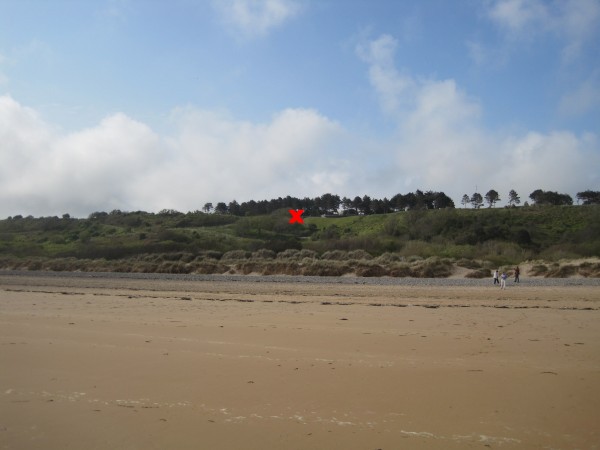 |
"On D-Day at
this exact spot, Captain Joseph Dawson of G Company crept on hands
and knees to within ten yards of a deadly machine gun nest.
Suddenly two Germans saw him.
As they swung
their machine gun around, Dawson threw a grenade to eliminate the
threat. It was kill or be killed.
This was the
moment upon which the fate of the day turned.
This brave
action cleared the way for the men pinned down on the beach to climb
the hill.
This
Breakthrough Moment saved the day for the Americans."
|
 |
In Joe Dawson's
book, From Omaha Beach to Dawson's Ridge, Dawson had
this to say about revisiting Omaha Beach with Karas.
"Yesterday,
I took a little trip to the rear - my first since my
return from the hospital. With my Executive Officer
Stanley Karas, we revisited the scene of our landing and
walked over the ground where we had fought. Indeed my
heart stood still as I placed myself in the enemy
positions. How I came across that beach will ever remain
the unshaken realism that God alone so will it.
From a purely abstract point of view and as a military
problem, I would say that such a place could not be
successfully taken by assault troops. It was just too
perfect a defensive position. Please don't ask me
how it was done because that will ever remain an
unsolved riddle."
As it turned
out, that one moment of rest with Dawson would be the last
peace Karas would enjoy till the end of the war.
Now that Karas
was back in action,
he was reassigned out of Dawson's company. Karas was promoted to Captain of E Company.
E Company
had suffered tremendous casualties at D-Day.
Since 140 of 200 of
"E" Company had died or been wounded, the
company was undergoing replacements and
reorganization.
Karas received a lot of new
people when he took over "E" but he also had Lt. Spaulding,
as well as Colson, Streczyk, and Bieder who were great
soldiers to build with. Ed Wozenski was Karas' immediate
superior.
E Company
immediately went into action. During the
infamous hedgerow nightmare of Normandy, Karas and his men fought every
day. Playing cat and mouse with the Germans in the
hedgerows and in the small French towns, the men were
constantly exposed to sniper fire. All the men
were at great risk every day.
One of the most famous battles of the Normandy campaign took
place at the French town of St Lo in July 1944. Karas
and his men were right there in thick of it. The
fighting was intense and dangerous while going door
to door in this small town. There were Germans hiding
everywhere. Many times life and death boiled down to
who shot first or who shot the straightest.
Just 23 days after taking
command, Karas and E Company saw brutal combat at Aachen on
the German border.
Captain Karas distinguished himself greatly during this
action. First he received the Silver Star as
Commanding Officer of E Company. Shortly thereafter he
received the Bronze Star as well. In addition, Karas
was wounded for the fourth time here.
Engaging in vicious hand to hand combat with a German SS
officer, Karas won the battle, but ended up in the hospital.
The wounds did not stop Karas.
Soon he was back at the head of E Company to finish out the
war. In March 1945, E Company got lost in
the middle of Germany. After heading down the wrong
road, Karas and his men encountered unexpected resistance.
After fierce combat, his unit ended up capturing an entire
town all by themselves.
After the war, Karas stayed on to help
with the chaos in Europe. He met an attractive young
Polish lady named Kay who had been driven from her home
during the war. After a six month courtship, he
finally received permission from the brass to marry her.
The ceremony took place in October 1945 at Wolfhagen, Germany,
where Karas was stationed.
Two years later the Karas family moved
to the USA The couple had two children, Stanley Jr and
Barbara.
Now back in the States, Karas was
committed to a career in the service. Not only was he
appointed a Major, Karas became head of the army recruiting
station in Elizabeth, New Jersey. Karas would go on to
serve as a liaison officer during the Korean War.
Stanley Karas would rise to the rank of Lieutenant Colonel
before retiring.
Stanley Karas was nominated for the
Congressional Medal of Honor. Unfortunately it never
came through.
Rick Archer's Note: There is much more
to Stanley Karas' service record. However,
his son told me that his father probably would
prefer to keep the details of his war exploits
private.
It is only right to honor
those sentiments.
"My Dad was such a normal
guy, fun to be around. You would never guess
there had been violence in his life. He was
a modest guy. I'm sure he would approve the
credit be focused on the group, not
himself." Stan Karas, Jr.
|
|
| |
|
Stanley
Karas and Breakthrough Alley at Omaha Beach
Stan Karas was
heavily involved in the D-Day attack on Omaha Beach.
The problem is, it is difficult to find any mention of his
role that day. This is a bit strange because Stanley Karas was the second in command of
Company G behind Joe Dawson. In other words, Stan
Karas was Joe Dawson's executive officer. One would
assume Karas was in thick of the action all day long.
However, despite
his important position, there are only two brief references
to Karas in Dawson's book about World War II From
Omaha Beach to Dawson's Ridge. Both references
are very cordial, but have nothing to do with the fighting.
So why do you
suppose Karas' son read my article? Because Stan Karas
Jr is always curious about any article that discussed the
action his father was involved in at
Omaha Beach.
In the reports
of G Company's movements during D-Day, the name 1st Lt Karas is
not to be found.
There is a reason for that.
Karas was hurt
during the D-Day offensive, so he wasn't around afterwards
to give interviews. When he returned to
action a month later, Karas was immediately transferred to the command of another
company.
This meant Karas was
too busy to be bothered with interviews. This also
explains why Karas was not part of the G Company Group
Interview in August 1944 regarding their memories of
D-Day (this interview is listed below). Consequently Stan Karas'
name doesn't appear in the reports.
It is hard to
believe that the Executive Officer was largely invisible
that day. On the other hand, let's be realistic. Everyone was too busy
ducking bullets to recall what Karas did. Karas was
undoubtedly ducking bullets and shooting back just like everyone
else.
I think we can
infer that Karas participated heavily in the horror of
Bloody Omaha. However, it is unlikely we will ever
know exactly what he did that day. More than likely, Karas
was far too worried about staying alive than be concerned
about his press clippings.
It was just his bad luck
to get hurt. Just three hours after
opening the lane that broke the day open for the Americans, Karas lay
unconscious and temporarily blinded from his eye injury at Colleville. As his son pointed
out, Karas took one in the side of the head at Colleville
and woke up in a hospital in England. He filled out no
reports and was not interviewed.
For that matter, the
concussion might have erased his memory. There is a
chance Karas didn't even remember half of what happened.
Compounding the
problem, after the war, Captain Karas preferred not to talk
about his war experiences with his son. Yes, he gave
interviews all the time to newspaper reporters, but Karas
always kept it superficial.
I have heard
that many veterans have great difficulty talking about the
experience. It is just too painful to think about… so many
close calls with death, so much fear, so much guilt and regret, plus
the helplessness and the pain of seeing so many friends die
fighting. After the war, those guys had to be shell shocked
out of their minds. I can imagine the only way they could
cope with those horrible memories is to wall them off in
some secret part of their mind and refuse to unlock the door
ever again.
From what I
gather, Captain Karas required no publicity of his war
feats. He was perfectly content to help send Hitler to
his grave and leave it at that. This sense of modesty
in the face of so many accomplishments is typical of many
American GIs. They did their job and didn't expect any
fuss made over them.
Since so little
was documented about his role that day, Captain Karas joins
the
thousands of other men who will go down as the Unsung Heroes of D-Day.
Karas risked his
life and did his job without any need to receive personal glory.
Because of men like
Officer Karas, his son, his daughter and all the
rest of us Baby Boomers are lucky enough to enjoy a life of
peace and prosperity here in America.
Men like Karas and his
friends not only risked their lives so that the next generation could
be safe from a monster like Hitler, many of them sacrificed
their lives.
Thousands of men died
that day so that you and I can be safe.
We can never forget
that.
|
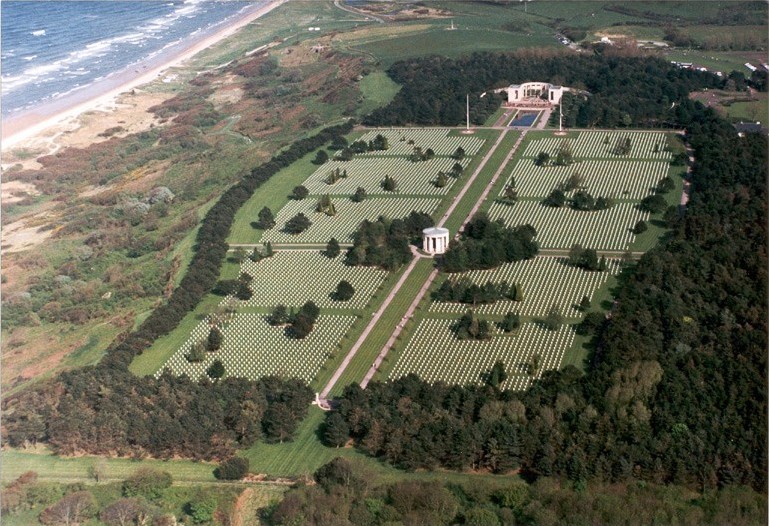 |
The Contribution of Captain Karas' Son
Captain Karas' son Stan Jr has long been curious about his
father's career. Understandably proud of his father
and curious to learn more of what happened that day, Stan Jr has read every book he can
get his hands on about Omaha Beach and World War II.
Stan Jr liked my
article in particular since my story concentrated directly
on the Breakthrough led by Captain Joe Dawson at Omaha, the
same historic moment that his father had participated
in.
Stan Jr wrote
this about my story:
From: Stan
Karas
Sent: Wednesday, March 14, 2012 5:25 PM
To: Rick@ssqq.com
Subject: D-Day story
Dear Mr. Archer,
I just have to thank you for such an incredible job on
your Normandy story. So thorough!
Not only are the photos amazing, your story gave such
clarity to someone who has more than a casual knowledge
of this subject. Thank you for the insight.
The 1st Division Museum in Illinois I think would be
very interested.
I recently retired and visiting the Normandy Beaches is
high on my "Bucket List".
My Dad was a 1st Division soldier, in fact he is Lt.
Stanley A. Karas 0885734, Executive Officer of "G" Co.
2nd Bn 16th Inf. on 6Jun44.
Sir, you have given me such a vivid picture of what this
must have been like for them. Thank you so much. My
father was wounded later in the afternoon at
Colleville-sur-mer. It was his third of four wounds.
Despite nearly losing his eye, my father returned to "G"
Company in a few weeks.
In September 1944 Capt. Wozenski was promoted. At that
point, my Dad became C.O. of "E" Company until the end
of the war. "E" Company was thrown into action almost
the moment Dad took over. In late September, my father
earned the Silver Star at Aachen. Not long after that,
he also received the Bronze Star at Aachen, a brutal
fight indeed.
Dad retired from the army in 1957 as a Lt. Colonel. If
you read Walter Bieder's interview in the War
Chronicles, the Capt. "Caras" he refers to is actually
my Dad.
As you can gather, I am very familiar with the soldiers
of the "G" and "E" Companies.
In my opinion, your presentation of these events is the
best I've ever read!
On a personal note, I was fairly young when my Dad died
in 1970. Like many men who served during the war, my
father never wanted to talk to me about the war.
As a result, I never really had many details about the
war until Capt. Dawson's book came out. Since then, I've
gathered a lot of details about Co's G and E. In fact,
Rosalyn Dawson (Joe Dawson's daughter) and I have met.
We thought how much our dads would have liked that we
met and talked about our fathers who were heroes.
We both have pictures of my Dad in the same photo with
Ike and another with Omar Bradley. I think everyone in
my extended family has brought these to "Show and Tell"
growing up.
Your story will have so much meaning for them. Only
military buffs realize the amount of combat the 1st
Division saw before (and after) D-Day.
You know how in sports they say good ball players make
their teammates better, well, the 16th Infantry Regiment
had to be the All Star of All Star teams for fighting
ability.
I looked up the amount of DSC's awarded to the 2nd
Battalion 16th Regiment in WW2 (my Dad has one for
Sicily). I guess that's why Ike picked them for
Colleville draw. Failure would have been catastrophic.
You said it was the most important site in US Military
History. I have to agree. I've read that 6Jun1946 was
the most important day of the 20th century.
The 16th Infantry Regiment are now Rangers. There is
even a Video Game CALL OF DUTY-THE BIG RED ONE. I am
proud that my father served in this legendary group of
men.
Thank you again, sir, for your excellent story and for
the respect you have shown for these men.
Yours truly, Stan Karas
Stan Jr is
particularly proud of one picture he has in his possession.
It is a picture of General Dwight Eisenhower at Balleroy,
France, on 2 July 1944 giving the men of the First
Infantry a pep talk. That is 1st Lt Karas circled in
the background.
General Dwight D Eisenhower was there to personally present
the DSC medals to American soldiers. You can see the
picture of Captain
Joe Dawson as he receives his medal for his heroic part in
creating the American breakthrough that day.
Eisenhower gave
a heartfelt salute to the men of the Fighting First.
He said, "I know your record from the day you landed in
Africa, then Sicily. You are a remarkable group of
men. I am beginning to think that the First Division
is a sort of modern day Praetorian Guard."
The Praetorian
Guard was the elite fighting force of the Roman Empire.
High praise indeed.
As Stan Karas Jr
pointed out, "I
guess that's why Ike picked these guys for the Colleville
draw. Failure would have been catastrophic."
|
|
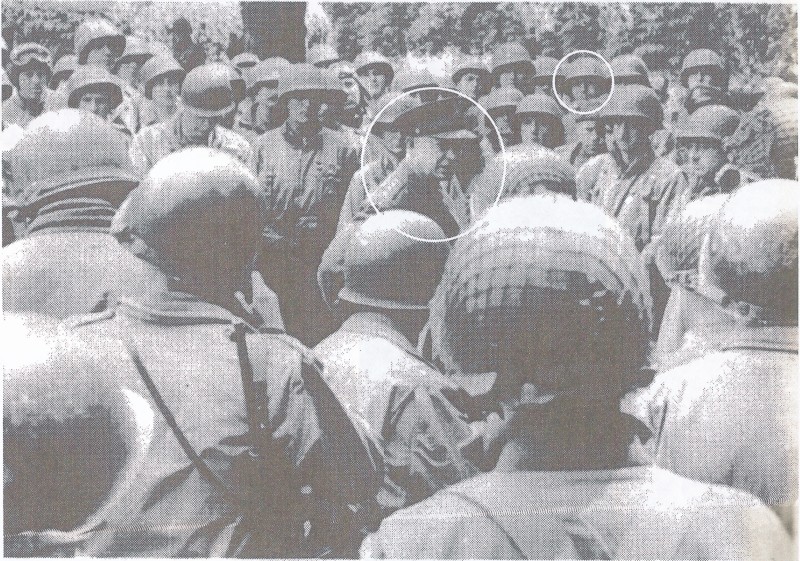 |
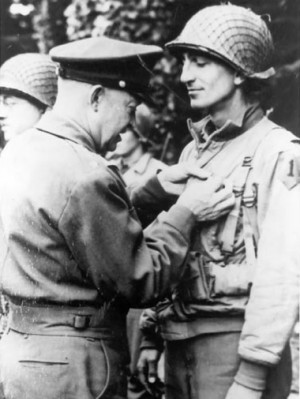 |
|
| |
|
Testimony to Stan Karas
Rick Archer's Note:
If you are
reading this page first and you are unfamiliar with the long version
of my story, here is a brief recap. On D-Day morning, two units landed in roughly the same spot about 15
minutes apart.
Working separately, Company G led by Joe Dawson and Company E led by
John Spalding took the initiative to blow holes in the barbed wire
and climb the hill in front of them through a steep gulley.
Essentially
Dawson and his men wiped out the resistance on the "WN62" side of
the gulley while Spalding and his ace Second in Command Streczyk
wiped out the "WN64" side of the same gulley.
At the top the
two units met. Spalding decided to move west. His unit
would discover and destroy Resistance Nest 64, a major step in the
victory.
After Dawson
personally eliminated a dangerous machine gun position to clear the
way, his orders were to take his company towards Colleville.
|
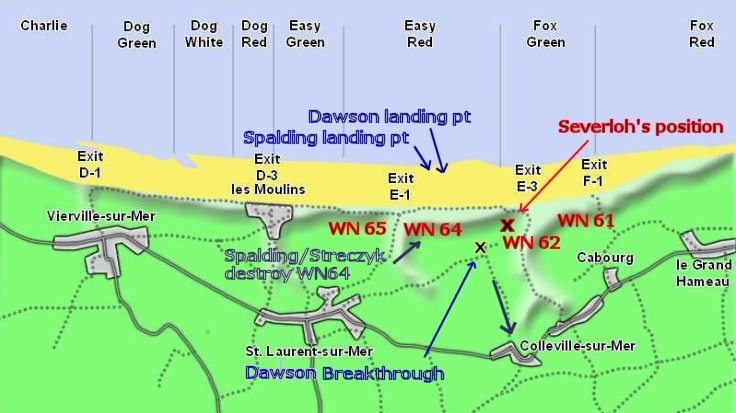 |
Thanks
to my communication with Stan Karas Jr, he offered to send
me the transcript of a group interview held with the men of
Company G about their experiences at
D-Day. If you have read my long story, you will
probably not learn anything new. However the Interview will
certainly drive home the valuable message that these
men were brave and heroic in their actions on D-Day.
As I
read their story, I wondered if these men realized just how
significant a role they played that day. These
were the men who punched the first gigantic hole in Hitler's
Atlantic Fortress at Omaha. We were losing the
battle that morning at Omaha Beach. Men were dying
right and left and unable to move thanks to a rain of
artillery and machine gun fire. Suddenly, once Dawson's men
opened the door, hundreds of men were able to pour through that opening
and
take control of the fight. We won that day thanks
largely to this amazing exploit.
Please note that the name of 1st Lt Stan Karas is nowhere to be
seen in this interview. Karas was not there to
participate in this interview because he had just been assigned
to take
command of Company E. As the new Captain, Karas was
surely busy elsewhere that day.
As a
result, Stan Karas' exact role in the events of D-Day is
likely to remain largely
invisible for the rest of time. This is a shame
because as Dawson's right hand man, Karas undoubtedly played
a major role in his own right on D-Day.
Stan
Karas has been one of the Unsung Heroes of the D-Day
Breakthrough for over half a century. Now we all know
who Stan Karas is. He is a highly decorated war hero
who once took on 5 German tanks all by himself. Karas
was an incredibly brave man who was wounded in action four
times and yet risked his life to return to fight again
four times. This is a guy who deserves all the respect
and gratitude his country can give him.
It has
been a real pleasure to add the name of Stanley A. Karas to this
amazing story.
|
An Account of Breakthrough Alley
Rick
Archer's Note (6 June 2012):
This
is an eye-witness account given by the men of Company G that
explains in their own words how they created the opening
that saved the day. Countless Americans were pinned
down on the beach by deadly machine gun fire. The
Americans had been unable to disable the near-invincible
German WN Resistance Nests using a frontal assault.
The countless dead bodies lining the beach was morbid proof
of that.
No one
was moving; the attack was in so much trouble General Omar
Bradley assumed the Americans had failed at Omaha Beach.
Then suddenly men began moving off the beach.
A safe
route to the top had miraculously appeared. The
momentum of the battle pivoted instantly.
From
there the troops fanned out and took down the Resistance
Nests one by one from behind.
I do
not believe this report has been previously published on the
Internet.
A Group
Interview with Company 16-G
Interview
conducted on
August 22, 1944
|
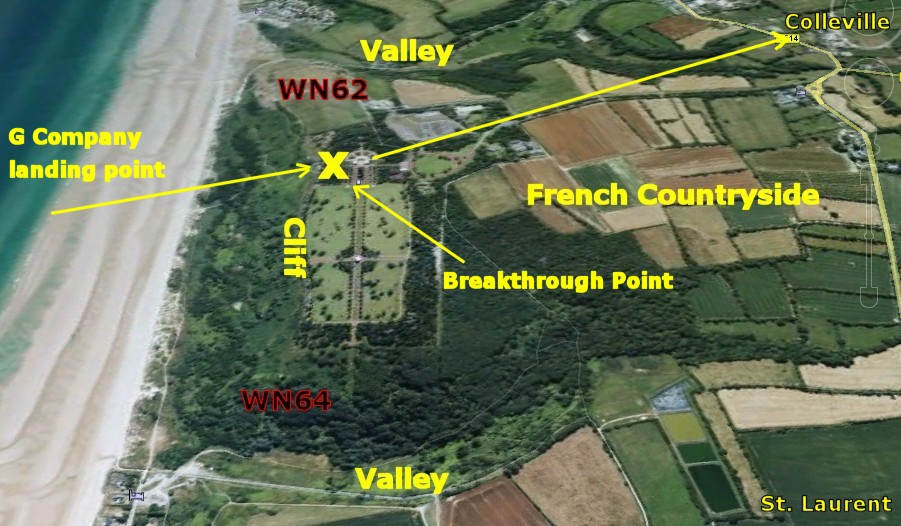 |
Our Company
hit the beach together except for the 5th
Battalion. They were taking in too much water and
couldn’t bail fast enough so their boat was slowed well
behind us. G Company
came in on 6 LCVPs (Landing Craft, Vehicle, Personnel).
There were no casualties coming in.
Bullets were dropping around
us like rain but the good Lord seemed to be with
us. (Capt Joe Dawson).
Armor-piercing shells and high explosive shells were
hitting in and around the Company. These explosives
were having a harassing effect on the men, but
fortunately the nearest did not fall closer than 50-60
yards away. (T Sgt VJ Miceli)
Battalion 5,
the one with the slower boat, found its ramp fouled and
unworkable when it got to the beach. The water inside
was then up to the men’s knees and this blocked the
mechanism. So the men had to clamber over the sides.
This made them a broadside target and they lost 15 men
to bullet fire.
The 2nd
Section hit a sandbar 700 yards out. The coxswain told
the men to stand steady and he bumped his way on
through. The coxswain seemed absolutely fearless. He
kept assuring the men that he was going to get them in
safely at the right place. He paid for his courage with
his life. He tried to straighten the boat around after
he dropped the men and a shell made a direct hit on him.
(Lt. EA Day)
The water was
still quite clear when Company G hit the beach. The
Company was supposed to land a H plus 30 and did so at
the designated spot. However the few men who had
preceded “G” to this part of the beach had been delayed.
Consequently they were only 5 minutes ahead of us.
(Dawson)
The engineers
were engaged in blowing the tetrahedral and trihedrals
(Rommel’s ‘Belgian Gate’ defenses) when the company came
ashore. The men of ‘G’
saw some men trying to land behind them (116th
Infantry and CWS troops). They were trying to take
cover behind the obstacles. Unfortunately, they were in
the wrong place at the wrong time. They died when our
own explosives took out the obstacles. (Dawson, Miceli).
The engineers
had not yet completed the lanes for the tanks; it was
about 15 minutes after ‘G’ landed the first lanes were
cleared in this area. However three tanks had arrived
at this strip of beach. Where they came to shore is not
known. They had already been destroyed by direct
artillery fire from the shore batteries when “G’ landed
among them. These were the DD tanks that were supposed
to have preceded the first wave by 5 minutes. Out of
the 60 DD tanks, only these three had made it to shore.
Ten tanks had drowned at once and other had foundered as
they came in. All the way in, the men of ‘G’ had passed
tankers afloat on rafts and had mistakenly thought they
were markers intended to guide
the infantry. (Dawson, Miceli)
The height of
the surf was so great that men
in the ‘G’ boats were making
to one another none of their own craft would be able to
reach the shore. (S Sgt Vincent J Kachnik)
The scene
along the shingle as ‘G’ landed was one
of complete confusion. The assault wave had become
pinned down, mentally if not physically.
(Dawson)
There was no
coordinated fire from the Americans ashore. ‘G’ could
see a line of men along the shingle, frozen to earth and
taking no steps against the enemy. They were bunched
should to should and were huddling on patches of ground
which gave them partial cover from the fire. (Dawson,
Miceli)
These men
were mostly remnants from ‘E-16’ under Spalding but
principally 116-E who had been landed on the wrong beach
and had become demoralized in part by that error.
(Dawson)
The beaches
were supposed to have been saturated with rocket fire
from the 5 LCRs (landing craft rocket). One LCR hit the
target and got its rockets into the E-3 draw. However
the other rocket clusters had gone off in the water
quite far from the shore. Our men passed thousands of
dead fish killed by this fire. (Dawson)
Most of the
‘G’ casualties were suffered getting from the boats to
the shingle. We lost 63 men all told. They fell mainly
from mortar and bullet fire. The enemy artillery was
falling too far behind to be dangerous. There was no
way, however, to minimize these beach-crossing losses.
The men had to walk across the sands’ they could not
sprint because the weight of the ammunition, demotions.
(Dawson)
It was the
feeling of the men that our losses would have been cut
in half if the loads
had been lighter. (Miceli)
When the
ramps went down, some of the men couldn’t move ashore.
They stumbled and fell in the water. They had become so
cramped because crowding that their muscles would not
respond. They lay in the
water for a few minutes, rubbing their legs. Finally
when the circulation was restored, then they crossed
ashore. (Lt Marvin Stine)
It even
seemed to some of the leaders that they were glad of the
chance to assault, so miserable had they felt during the
journey in. (T Sgt Peter Gorba)
Except for
the wounded and perhaps a few stragglers, the men
streamed on up to the shingle. The light machine guns
and the mortars were all with Dawson. He put the
machine guns up on the shingle and the mortars at the
base of it. Five minutes after hitting the shingle,
these weapons were ready to fire. At first the men
could see no targets, so they put down a general zone
fire. At least 10 minutes passed in this way. Then new
boat waves came into the beach. At that, the enemy fire
shifted from the beach and shingle over to the oncoming
boats. (Miceli)
These new
boats caught all the unshielded hell that ‘G’ Company
had been dealing with. When that happened, our men at
the mortars and machine guns had their first chance to
see the targets clearly. They spotted 8 or 10 different
emplacements. Some of them looked liked Tobruk pits.
We directed all our fire towards these points. The BARs
(Browning Automatic Rifle) and rifles added to the
volume. We tried to put rocket fire n the emplacements
but the rockets were ineffective. So was the mortar
fire. (Day)
The open
emplacements were directly to the front of ‘G’. The
heavier guns were off to the flanks. ‘G’ Company
profited by the fact that there was a small defilade
directly ahead. This was what helped must in getting
the advance going. (Kachnik)
(Note: A
defilade is protection from hostile observation and
fire provided by an obstacle such as a hill, ridge, or
bank.)
There was
barbed wire everywhere. Two double aprons and a
concertina about 10 feet wide. The wire was 5 yards
beyond the shingle. While the
offensive fire was being built up, 5 men form each
section below the wire ahead of them with bangalores.
They had to use 4 bangalores to cut one lane. These men
accomplished this despite a hail of bullet fire.
(Dawson)
Pfc Henry
Peszek wiggled through and under the wire with Lt John
Burbridge. They got part way through and Burbridge got
his pack hung up. He shook himself loose. Peszek
yelled to him, ‘Keep going! I’m going back for the
bangalores.’ Peszek then exploded two of them. Both
men were lying within 6 feet of the torpedoes when they
exploded, but were not hit. Peszek got creased on the
arm by bullet while laying the second torpedo, but was
able to keep working. (Dawson)
Thanks to
these men’s efforts, this route was the best placed and
cut lane along the beach. Through it, most of the men of
‘G’ passed. All the battalions that came after us took
the same route. (Dawson)
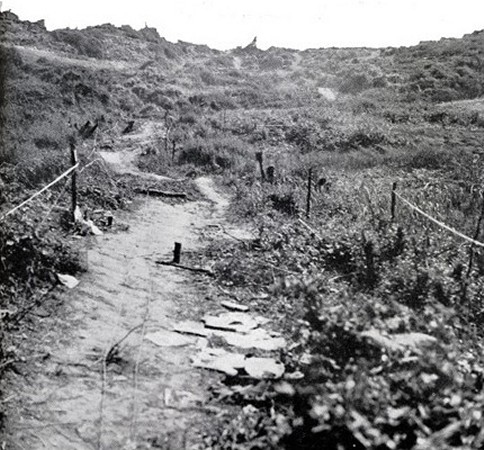 |
A mine field lay beyond the wire. There
were two dead Americans lying in the mine area. They had
stepped on mines and lost their lives.
Those bodies were
a grim reminder to be careful that we all took note of.
The men of ‘G’ went through the field by
walking over the bodies of the two dead men.
|
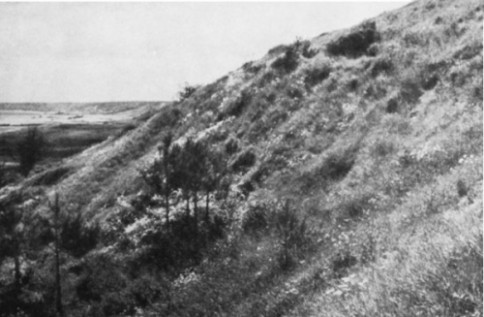
Note: These are two pictures of the ravine or
"draw" that Dawson and G Company climbed. Those ropes in the
picture on the left were placed shortly after D-Day to show the safe
route to the top. There were dangerous land mines on either
side.
|
We figured that this was the safest route. We
then continued through the Roman Ruins and proceeded up
the draw.
(Day)
(Note: a draw is a small natural
depression that water drains into; a shallow gully).
|
Dawson was
out ahead of them. Dawson had crawled through the wire
and had gone on up the hill with Pfc Frank Baldridge to
see if he could clear the way for his men.
They got
halfway up the draw, but were pinned down.
Dawson found
himself caught between the fire of his own men and fire
from any enemy machine gun at the head of the draw.
Having walked up to that point, they dived next to a
fallen log for cover.
Dawson told Baldridge, ‘Leave
your equipment here. Go back and get the rest of the
company.’ (Pfc Frank Baldridge)
|
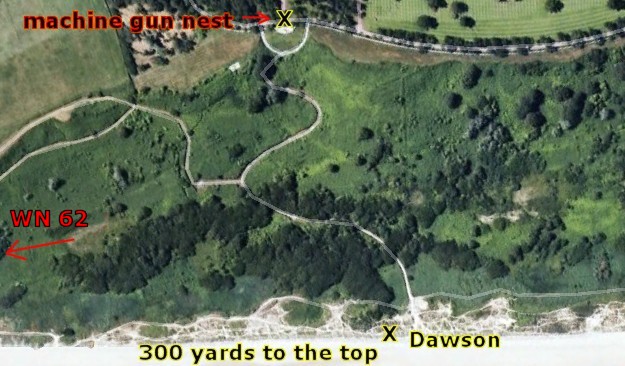 |

After Baldridge left, Dawson
was on his own. Dawson crawled
forward up the draw another 75 yards. He moved to any cover he could
find.
The draw was V-shaped. The Roman ruins were
behind him down at the wide bottom of the V. There was a promontory
at the top near the left angle of the V.
As Dawson got closer,
the steep promontory likely shielded Dawson from the sight of the
machine gun nest. He was now invisible.
Dawson crawled behind this
outcropping and around. This move put the
enemy emplacement a little behind him and to his right.
Dawson got within ten yards when the
Germans spotted him. They swung their
machine gun around and fired it wildly.
Dawson heaved a fragmentation grenade. It
exploded between the two Germans and killed both men instantly.
(Miceli)
|
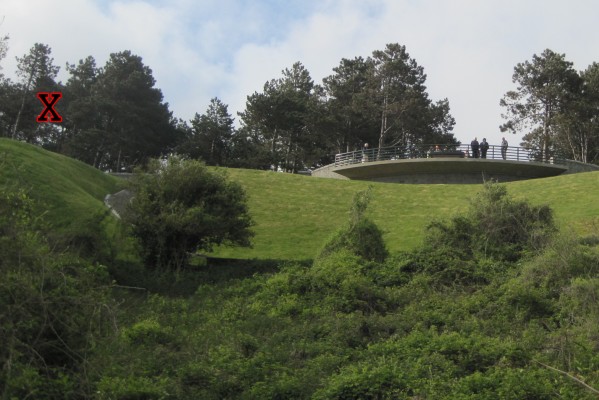 |
Dawson then
waited at the brow of the hill for the company to come
up and join him. As the platoons reached the top,
Dawson deployed them. Baldridge, the messenger, had met
the
5th Section under Lt Kenneth Bleau already
coming up the hill.
Kachnik had gotten forward as far
as the Roman ruins only to discover that most of the men
weren’t following Bleau. Kachnik went back to the beach
and learned that in the interval the Assistant Section
leader had been hit and there was no one to boot the men
on. Kachnik went to work on them and before long got
the majority of the men moving up the hill. Kachnik
then followed along. Coming towad the top of the hill,
Kachnik saw ‘Achtung minen’ signs to his left. Kachnik
heard someone say ‘Try the right instead!’ (Miceli)
There were
more signs in that direction too. So Kachnik tried
looking for a path. He began to crawl on his belly
through the field. Four men followed him – S Sgt Joseph
Gaetano, Pfc Richard Torrey, Pvt Leo Sheerer, and Pvt
Louis Johns. They encountered no mines and crawled all
the way to a hedgerow beyond the field atop the hill 200
yards forward. I (Kachnik)
sent Sheerer back with the word ‘It’s safe. Tell the men
to come ahead.’ (Kachnik)
The Company,
however, was already coming forward, using the trail
I (Kachnik)
had marked. Now that the men were on top of the hill,
the enemy fire by now had almost ceased. The men of ‘G’
continued forward for 1000 yards. Then they saw a group
of Germans milling around 150 yards to their left. S
Sgt Joesph Barr moved out along the hedge with an M-1
and took 8 prisoners, routing them from out of a
dugout. They were a mixture of Germans and Poles.
Earlier the Company had seen mortar fire coming from
this position and had thus spotted the enemy group ahead
of time. (Kachnik)
The other
elements quit the shingle and came on up behind ‘G’.
Many of the men stayed in the draw Dawson had used
because the cover was better. Except for the men lost in
the water and crossing the beach, Dawson had brought
every man off the beach and up the hill with no further
casualties. Dawson did not have a single malingerer.
To the eye of Kachnik, it seemed that the new men came
along quite as determined as Dawson’s men, perhaps in
some cases with even more dash. In the journey across
the mine field, part of the Company had been guided by a
Russian POW that had been found at the top of the hill.
(Miceli)
Back on the
beach, the work of rescue proceeded with T-5 Ray Smith,
Pvt Abraham Nearon and Pvt Philip Kalan, aid men whose
help figured conspicuously in saving the lives of the
wounded. They worked back and forth dragged the wounded
from the sands before the tide could overtake them.
Smith, an unusually large man, made three trips across
the beach carrying men on his back or in his arms.
Smith was hit the leg and Kalan in the side for their
efforts, but both men kept working until the next day
when both were evacuated for wounds. Also conspicuous
for his work on the beach was Pvt James Stickles. He
worked for several hours away from the cover of the
shingle patching up men. A private named Meadows was
hit by a bullet while crossing the mine strip just off
the beat. T-5 Smith crawled out, got him, and carried
him to the shingle on his back.
COLLEVILLE
SUR MER
Note:
Now that Dawson and
‘G’ Company had cleared out all remaining resistance at
the top of the hill, their next mission was to move
inland and attack Colleville-sur-mur a mile away. There
were many German reinforcements stationed there.
Dawson’s responsibility was to limit their ability to
counter-attack by attacking them first.
The plan was
for the 3rd and 4th Sections to
attach the German bivouac area after which the whole
Company would pivot against Colleville. 1st
and 2nd Sections would then advance on
Colleville while the others would remain behind as a
reserve. They proceeded to operate on the plan. About
12 men were lost in clearing the enemy from the bivouac
area in a close-up house-to-house action fought with
rifles and grenades. After this job was complete and the
company made the left turn, Dawson found the fire from
the Colleville positions building up against him at such
a rate that he realized he could not take the village.
The hour was 1300 and his men had penetrated the edges
of the community. Burbridge’s 1st Section
anchored the Company there, containing a few buildings
along the outskirts. Bleau’s 5th Section tied
into Durbridge and extended the company’s line to a
group of building just short of the bivouac area.
Lt Day’s 2nd
Section closed the perimeter. Dawson sent word to Lt
Col Hicks at 1430 that he could not commit the Company
to the attack on Colleville. Dawson was partly
influenced b the fact that the two other sections under
Stine and Lt James Kruckas had became separated from the
Company. They had gone on to high ground about 1000
yards beyond. They extended themselves to cover the
exposed flank, this being done at an hour when it was
still reckoned that the other three sections could take
Colleville. The enemy then filtered in behind the two
sections. They did meet organized resistance but
riflemen coming in on the flanks picked off one officer
and two men.
At about
1500, the 18th Infantry came through ‘G’ and
on South of Collevillle, passing the Germans of
Colleville. ‘G’ continued to hang on to Colleville’s
flank. At 1630, the US Navy opened fire on Colleville
and swept the town from end to end. Dawson’s ‘G’
Company took 8 casualties thanks to this unfortunate
fire which landed right on top of G Company’s position.
The cordite fumes became so intense that all of ‘G’,
including the aid men attending to the wounded, had to
carry on in gas masks. Orange smoke was sent up by the
fire continued. It was lifted at last by a radio
message put through to Battalion. The enemy in
Colleville did not waver during the fire. POWs taken
the next day by ‘G’ reported the German side did not
lose a single man during the shelling. (Dawson)
Dawson was
getting small arms fire from all around his perimeter.
Losses were occurring, but there was no place to
withdraw the men. The arrival of the 18th
Infantry had caused a slackening of the fire for a few
minutes, but when the larger group went on, the fire
picked up again. Dawson was hit in the knee but felt
that he had o stay on. Eighteen men in the three
sections had been either killed or wounded by the
American naval fire or enemy bullet fire while the
Company clung to the flank of Colleville during the
afternoon.
In the
meantime, three things had happened. The 16-1
had started arriving at 1300 and had gone into position
on ‘G’ Company’s rear. Their later elements continued
to build up throughout the mid afternoon. ‘G’ was not
in contact with them and did not even know they were
there, but gradually the enemy fire from that art of the
perimeter fell away to a whisper. The night was fairly
quiet.
At about 0800
the following morning, Dawson put his first patrol
through the town – Burbridge, Gaettano, Kruckas, Peszek,
and 4 others. They worked down the main road, moved
carefully from house to house. They shot a few enemy
riflemen and captured eight prisoners. AS they reached
the edge of the town, the 20th Engineers and
some MPs came along behind them. The patrol was
followed by exactly one block by an MP carrying “Off
Limits” signs. Gaettano cleaned out one house, went on
a short distance, went back and tried to reenter the
same house because he wasn’t certain whether he had
completed the job. An MP said ‘You can’t go in there!’
Gaettano replied ‘The hell I can’t! Just try to stop
me!” So he went in. (Burbridge)
At 1000
Dawson was ordered to displace the Company to the south
side of the town. They went 200 yards and drew fire.
Dawson got two sections up to high ground and built up a
fire position. 18th Infantry was 500 yards
behind. In a 15 minute engagement, ‘G’ disposed of 17
Germans who had gone by an underground passage from the
barracks in Colleville to prepared position outside the
village. They had gone out in the early morning. One
60 mm shell that landed dead center took all the fight
from this crew. ‘G’ killed 5 and captured 12 more,
suffered tow wounded men in the skirmish.
It
was Dawson's impression that the lanes cut by his Company
in the wire were used by the 18th, 26th
and elements.
|
Giving
Credit for the Breakthrough
In the Group
Interview, the concluding line said Dawson
believed that the lanes cut by his
Company in the wire were used by the 18th, 26th
and elements. Dawson was too modest
to come out and say it, but this opening plus the
elimination of all resistance up the draw allowed the
Americans their first real chance to take the initiative.
Once I realized how thoroughly my
friend Stan Karas Jr had studied Omaha thanks to his
father's involvement, I decided to interview him about his
thoughts.
Question 1. Do you ever wonder
why Dawson didn't get the Medal of Honor? After all, he and
his company created the first breakthrough of the day. Who
did more to turn this battle around? What did your father
think about that?
Karas Repy 1- Usually all DSC winners are
given consideration for the CMH (Medal of Honor). My
Dad was told he was put in for it, but he didn't get it. The
fact finding is very thorough and time consuming. Sometimes
witnesses have since been killed. There are very few CMH's
that are survivors. In the beginning, the Allies were not
that ready to admit what a disaster Omaha almost was.
Perhaps honoring Dawson might have revealed to reporters how
close we had come to defeat. Credit
had to be shared with all nations and branches of service.
I think Steven Ambrose was the
first person to realize the magnitude of "G" Company many
years later. Cornelius Ryan doesn't even mention them.
My Dad took one in the side of the head at Colleville and
woke up in a hospital in England, so he filled out no
reports and was not interviewed. He probably only got all
the details of how many troops came through the breakout
after he returned to "G" Company. Dad or anyone else,
probably didn't realize they were making the "only" hole at
the time of the climb. They probably all were hoping the
same thing was occurring all along the beach.
Question 2. There was a big controversy about who got
to the top first… Dawson or Spalding. Did your father ever
comment on that? It is still something of a mystery.
Karas Repy 2 - According to Stephen
Ambrose, many units claimed to have people on the top but he
credits "G" to be the first "company size" unit capable of
doing damage. Spaulding landed 15 minutes ahead, but
Dawson's force was 8 times larger. They probably each gave
each other credit. My Dad never told me one word about
D-Day.
Question 3. Dawson seemed like a very modest man. Did
your father ever comment on that famous incident where
Dawson took out the machine gun nest? Did I tell the story
of his sneaking up on the MG nest correctly?
Karas Repy 3 - In his book, Dawson's jokes
about "not knowing whether he was going to be shot from the
front or the back" when they were crossing the channel. "G"
Co had been through a lot of combat with Ed Wozenski and he
was now the "New Guy". All he wanted to do was take care of
his men and complete their mission. Because of Joe Dawson's
action my father lived through the day. Dawson will always
be a hero to me. General Eisenhower speaks about the
modesty of the US servicemen in WWII. They honor those who
didn't come home.
In fact, Dawson was a real hero, a guy
who recognized the situation for what it was and did not
hesitate to take fast action.
His superior officer Wozenski landed
in the wrong place. Dawson arrived on a near empty beach
drawing much less fire and has the where-with-all to get off
the beach immediately. He has a geology background and can
see they need to climb STAT. He also has the balls to
take out a machine gun nest singlehanded, then has the cool
to seize the opportunity. Dawson gets serious manpower
and weapons up to the top quickly.
The sad thing is that Dawson's men got
inland faster than the Navy thought was possible. So
the Navy begins to bomb their own men at Colleville in the
afternoon because no American could possibly be there yet.
What a horror! Dawson lost 50-60 men to friendly fire.
Question 4. What did your father say about that
important trip up the ravine? Did he ever share his
experiences from that day with you?
Karas Repy 4 - It's hard to believe it but
I didn't know the details of any of this until a few years
ago. I regret not finding some of these guys just to shake
their hand and say thank you.
Question 5. Streczyk and Spalding. Do you
know anything extra about those guys? I can't help but
wonder if Streczyk was the actual leader. Spalding keeps
coming across as a college kid completely out of his
element. I don't know what Streczyk told Wozenski and all
the reporters, but to read some of the battlefield reports
makes Spalding seem either invisible or inconsequential. Any
comments?
Karas Repy 5 - Streczyk was a legend.
He was such a good thing for the Company. The first-time
guys in combat need a guy like this. The military is all
about TEAMWORK. Every boat had a "Plan B' AND a "Plan C"
guy. I thought Spaulding shined. Sometimes being a good
commander means listening to your subordinates. The writer
Joseph Balkoski gives everyone a lot of credit. Wozenski was
a few 100 yards down the beach and saw what he wanted to.
The men loved Streczyk.
I think you are pretty close about the
Wozenski/Streczyk thoughts. Ed Wozenski was a soldier's
soldier. He went on the become a General during the "Cold
War" era.
My Dad, Dawson and Wozenski all
entered the Army before the war started and were all about
30 years old on D-Day. They all had a deep commitment to the
men in their care. They worked very closely with each other
in England preparing for the invasion because E Co (1st
wave) and G Co (2nd wave) were landing on the exact same
sector of Easy Red beach, 15 min apart. Of E Co, only
Spaulding's boat landed at the right place.
Ed Wozenski was a Lt. in "E" Co in
1941. In Africa Wozenski became C.O. of "G" Co. and met
ANOTHER "Polish Sergeant from New Jersey" who spoke Polish
and German - my Dad. At the beginning of WWII the 1st Div.
was heavily comprised of men from the NYC area.
Who knows for sure but I think Ed
Wozenski had very positive input on my father's Battlefield
Commission, his DSC award in Sicily and his becoming the new
C.O. of "E" when Wozenski was promoted in Sept44. After
Sicily, the 1st Div. got a new Commanding General, Wozenski
became CO of Co E and Dawson went from Division Staff to new
CO of "G" Co.
In England Wozenski was back with his
beloved E Co. Although Dawson had been in combat, this was
his 1st time leading a group of men. I think Wozenski
felt better with my Dad as XO (Executive Officer) of "G".
My father and Streczyk had something
in common. Streczyk was "Plan B" for Spaulding's group
and my Dad was "Plan B" for Dawson's group. Both men
were there to lead if either commander fell. Not only
did Wozenski have strong feeling for Co's E and G, he needed
the support and protection from Spaulding's and later
Dawson's groups.
I think Wozenski thought so much of
Streczyk for what he had already done, that he made sure his
name was prominent in his reports.
Question 6. Finally, do you agree with me that there
should be a statue or at least a plaque at the observation
platform explaining the deep military significance of that
exact spot on the hill?
Karas Repy 6 - I would love it! You
noticed how much of the original plan failed or was sloppy.
Giving due credit to the Breakout would only accent how
close to failure Omaha was!
Imagine the further loss of life if
they didn't punch through!
So, I think they thought it might be
bad publicity at the time. Now, let the world know what
Dawson and Spalding did that day. It's time those two
companies got some long due credit.
|
|
| |
|
Rick Archer's Note
Thank you for reading my story. I consider it a great
honor to have this opportunity to share the stories of men I
admire so much. I completely agree that these men were
part of America's "Greatest Generation".
Yes, I
definitely have another chapter coming, probably many more.
In this Chapter, we have shined a much-deserved light on the
story of Stan Karas.
There
are so many
other heroes that deserve credit too. I cannot in all
good conscience fail to share their stories as well. I
think every year around the anniversary of D-Day I will try
to add new stories.
As you have
read, the information for this chapter was inspired by the
son of a man who fought at D-Day. If others have
information they would like to contribute,
I can be contacted by email at
rick@ssqq.com
If you would
like to read my complete story from the beginning, click
D-Day
Rick Archer
June 6,
2012
|
|
| |
|
|
|